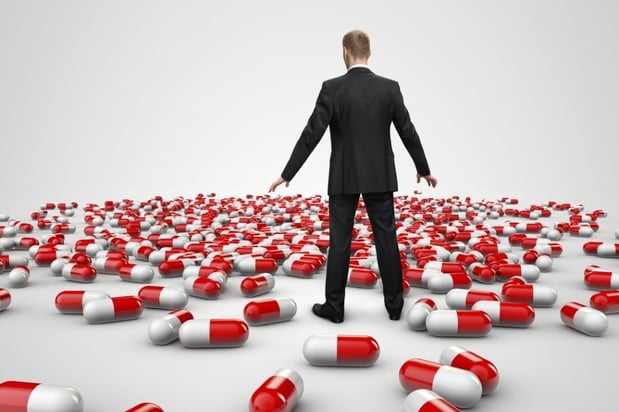Stimulants, or uppers, are drugs that increase brain activity by affecting the central nervous system (CNS). They increase mental alertness, physical activity, motivation and general energy.
The U.S. Drug Enforcement Agency (DEA), depending upon each drug's potential for abuse, classifies prescription stimulants as Schedule II through IV controlled substances. Many are classified as drug Schedule II, which requires a written prescription from a physician (healthcare provider) and does not allow refills on the prescription.
Illegal stimulants are classified as Schedule I because they have no approved medical use in the U.S. They are powerful and include drugs like cocaine. Some popular street names for stimulants are:
- Bennies
- Black Beauties
- Coke
- Speed
- Uppers
- Crystal
- Ice
Stimulants for Medical Use
Stimulants are used to treat medical conditions like moderate to severe Attention Deficit Hyperactivity Disorder (ADHD) and narcolepsy, the sleep disorder. Stimulants are also used illegally for recreational purposes to deliver enhanced feelings of euphoria and increased energy.
When used to treat ADHD, stimulants are effective in managing short attention span, impulsive behavior and hyperactivity. They are 70 percent effective in treating adults and up to 80 percent effective for children.
Stimulants, when taken as directed for ADHD, are not considered to be addictive. However, it should be noted that there is considered to be potential for abuse with any type of stimulant medication.
Common medications used to treat ADHD include:
- Adderall
- Concerta
- Dexedrine
- Ritalin
Types of Stimulants
There are several types of stimulants, legal and illegal, which include but are not limited to:
- Amphetamines
- Ecstasy or MDMA (3,4-methelenedioxymethylamphetamine)
- Cocaine and crack cocaine
- Methamphetamine
- Ephedrine
- Caffeine
- Nicotine
It is important to note that illicit stimulants include crack cocaine and Ecstasy (MDMA). Prescription stimulants are amphetamines, caffeine and nicotine. Over-the-counter stimulants include ephedrine.
Amphetamines
These are medications ordered by licensed healthcare providers to treat medical conditions, but often are abused by the patient or others on the street. As mentioned above, amphetamines are used to treat ADHD, narcolepsy, obesity and other medical problems.
Ecstasy or MDMA
This is a dangerous, illicit drug sometimes referred to as Molly. It is a hallucinogenic drug with stimulant properties and effects.
Cocaine and Crack Cocaine
Cocaine is used as a powder, which is snorted or dissolved and injected. Crack cocaine is heated and smoked.
Methamphetamine
This is manufactured from over-the-counter (OTC) medications from which the crystals are dissolved and injected.
Ephedrine and Pseudoephedrine
These substances are found in OTC cold and allergy medications. They are used to relieve asthma and a stuffy nose and can also lower blood pressure. The government has recently regulated these medications so they now require a signature and photo ID for OTC purchase.
Caffeine
Caffeine is found in coffee, tea and chocolate, and is sometimes added to sodas and "energy" drinks. It relaxes smooth muscles and increases urine flow.
Nicotine
This addictive drug is found in tobacco. It increases the blood pressure and pulse.
The Effects of Stimulants
When stimulants are smoked, snorted or injected, the user typically feels a rush or flash. The effects and/or side effects of stimulants can include the following:
- Increased blood pressure, respirations and/or heart rate
- Raised blood sugar
- Constricted blood vessels
- Sweating
- Increased risk of cardiovascular issues like heart attack or stroke
- Insomnia
- Constipation
- Diarrhea
- Dizziness
- Dry mouth
- Headache
- Improved attention, concentration and alertness
- Heightened stamina and endurance
- Euphoria
- Psychosis
- Hallucinations
The most concerning side effects of stimulants include the risk of psychological addiction. These drugs are commonly abused. The effects of stimulants, especially amphetamines, last between 6 to 12 hours.
Stimulant overdose leads to potentially lethal problems with the cardiovascular system and body temperature regulation.
Quitting Stimulants
Tolerance or needing more of the drug to produce the same effect quickly develops and escalates when stimulants are regularly used.
There are addiction rehabilitation programs, which include individual and group therapy, support group meetings and sometimes other medications, to help people quit the use and abuse of stimulants.
Withdrawal Symptoms
The general withdrawal symptoms experienced when stopping stimulants include:
- Extreme fatigue
- Irritability
- Depression
- General malaise
When stimulants are abruptly stopped, the user often experiences an energy crash. The typical withdrawal symptoms from stimulants can trigger a relapse in drug use. When used for the intended purpose, stimulants can have health benefits for the user. Illegal use of prescription and/or illicit stimulants can lead to physical issues and psychological dependence on the drugs.
If you or someone you know is seeking help from addiction, please visit our directory of treatment centers or call 800-772-8219 to start the path to recovery today.








